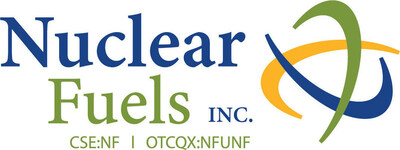Nuclear Fuels Releases Technical Report for the Kaycee Uranium Project
Exploration Target Identified of 11.5 to 30 Million Pounds
Significant highlights of the Technical Report include:
- An exploration target of 11.5 to 30 million pounds uranium ("U3O8) at average grades of 0.06% to 0.10%;
- A more extensive, in-depth review of historical data identified approximately 430 miles of roll fronts, an increase from the +110 miles previously outlined. Approximately 10% of the mapped redox trends have been explored with close-spaced drilling;
- The identification of the presence of multiple stacked roll fronts in each of the three stratigraphic formations that are known to host uranium mineralization;
- Indication the uranium mineralization lying under the water table may be amenable to In-Situ Recovery ("ISR"), based on historical metallurgical and mineral processing test work. ISR is an economical and environmentally responsible means of extracting uranium through wellfield technology and the use of oxygenated water, eliminating the use of conventional mining techniques;
- Details regarding the eleven (11) reported areas of historical uranium resources occurring at depths that range from less than 50 to 1,300 feet with a shallow water table typically lying between 50 and 250 feet.
- The Technical Report recommended that the Company should continue the current drilling program to delineate mineralization and explore for additional mineralized areas on the Project. In addition, the Technical Report recommended that the Company should prepare a classified mineral resource estimate for the Project, contingent on positive results of the drilling program.
To view project maps please visit: https://bit.ly/3NhnBdO.
Methodology to estimate an exploration target range based on historical data includes:
- Average grade and thickness for the mineralized zones in the Wasatch and Fort Union formations were calculated based on the historical data;
- Grade-Thickness calculated as weighted averages based on the number of drillholes in the various mineralized zones. Grade Thickness ("GT"), is defined as the product of the uranium grade (U3O8%) multiplied by the thickness of the intercept (in feet). In the
Powder River Basin ofWyoming , potentially ISR- recoverable uranium mineralization with a GT of greater than 0.20 is considered suitable for inclusion in a potential wellfield; - Outlines of the historically mapped mineralized areas were digitized with the area and length of the mineralized zones calculated;
- The average width of the mineralized zones was established by dividing the area of the mineralized zones by their length;
- The average width for each formation was multiplied by the length of the roll front trends to estimate the total area of mineralized trend for each formation;
- Mineralization does not occur along the entire roll front trend; therefore, a Trend Mineralization Factor was calculated for the
Wasatch and Fort Union formations by dividing the length of the historically mapped mineralized zones by the total roll front trend length for each mineralized zone; - The weighted average GT and Trend Mineralization Factor for the
Wasatch and Fort Union formations was used for the purposes of calculating an exploration target in the Lance Formation.
Kaycee ISR Uranium Project Exploration Target1
The Kaycee Technical Report can be found on the
In 2023,
The NI 3-101 Technical Report will be made available on SEDAR and the Company's website within the time prescribed by NI 43-101. The technical content of this news release has been reviewed and approved by
The technical content of this news release has been reviewed and approved by
About
1 NI 43-101 Technical Report - Kaycee Uranium Project WWC Engineering
The Canadian Securities Exchange has not reviewed this press release and does not accept responsibility for the adequacy or accuracy of this news release.
Certain information in this news release constitutes forward-looking statements under applicable securities laws. Any statements that are contained in this news release that are not statements of historical fact may be deemed to be forward-looking statements. Forward-looking statements are often identified by terms such as "may", "should", "anticipate", "expect", "potential", "believe", "intend" or the negative of these terms and similar expressions. Forward-looking statements in this news release include, but are not limited to, statements relating to planned exploration programs and the results of additional exploration work in seeking to establish mineral resources as defined in NI43-101 on any of our properties. Forward-looking statements necessarily involve known and unknown risks, including, without limitation, risks associated with the completing planned exploration programs and the results of those programs; the ability to access additional capital to fund planned and future operations; regulatory risks including exploration permitting; risks associated with title to our mineral projects; the ability of the company to implement its business strategies; and other risks including risks contained in documents available for review at www.sedar.com under the Company's profile. Readers are cautioned not to place undue reliance on forward-looking statements as there can be no assurance that the plans, intentions or expectations upon which they are placed will occur. Such information, although considered reasonable by management at the time of preparation, may prove to be incorrect and actual results may differ materially from those anticipated. Forward-looking statements contained in this news release are expressly qualified by this cautionary statement.
![]() View original content to download multimedia:https://www.prnewswire.com/news-releases/nuclear-fuels-releases-technical-report-for-the-kaycee-uranium-project-302269745.html
View original content to download multimedia:https://www.prnewswire.com/news-releases/nuclear-fuels-releases-technical-report-for-the-kaycee-uranium-project-302269745.html
SOURCE


